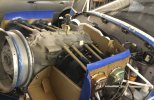2nd505th
Pre-takeoff checklist
- Joined
- Apr 11, 2018
- Messages
- 108
- Display Name
Display name:
2nd505th
Got this from Lycoming:
The prices for the O-235-L2C engine from Lycoming, on exchange, are:
Lycoming Factory Overhauled - $38,668
Lycoming Factory Rebuilt - $44,845
Lycoming Factory New - $66,561
Don't forget that only Air Power offers financing for all Lycoming Engines!
*PLEASE NOTE: if the core is more than 36 years old, Lycoming requires that you purchase either Factory-Rebuilt or Factory-New engine (Factory-Overhaul would not be an option). Unlike overhaul shops, the factory will not re-use parts that old. If you are unsure of your engines age, send me the serial number and I’ll find out for you.
Remember, there are no additional charges added later for normal wear or normal repairs on your old engine. In other words, there are no "we didn’t know about that until we opened it up" surprises. If your core is operable (with genuine Lycoming crankcase and crankshaft), active, assembled, and returned complete, this is a guaranteed price, not a penny more!
My question is that if Lycoming never uses old parts - why would they want my old engine back? All it's inner parts are more than 36 years old (except for the cylinders). It also means that no rebuilt has a part older than 36 years? Is this an industry standard - not to use parts over 36 years?
Does this also mean that a shop like Zephyr would use my older parts when doing an overhaul?
The prices for the O-235-L2C engine from Lycoming, on exchange, are:
Lycoming Factory Overhauled - $38,668
Lycoming Factory Rebuilt - $44,845
Lycoming Factory New - $66,561
Don't forget that only Air Power offers financing for all Lycoming Engines!
*PLEASE NOTE: if the core is more than 36 years old, Lycoming requires that you purchase either Factory-Rebuilt or Factory-New engine (Factory-Overhaul would not be an option). Unlike overhaul shops, the factory will not re-use parts that old. If you are unsure of your engines age, send me the serial number and I’ll find out for you.
Remember, there are no additional charges added later for normal wear or normal repairs on your old engine. In other words, there are no "we didn’t know about that until we opened it up" surprises. If your core is operable (with genuine Lycoming crankcase and crankshaft), active, assembled, and returned complete, this is a guaranteed price, not a penny more!
My question is that if Lycoming never uses old parts - why would they want my old engine back? All it's inner parts are more than 36 years old (except for the cylinders). It also means that no rebuilt has a part older than 36 years? Is this an industry standard - not to use parts over 36 years?
Does this also mean that a shop like Zephyr would use my older parts when doing an overhaul?
Last edited:


